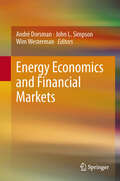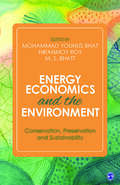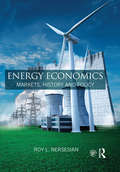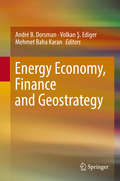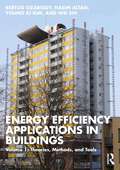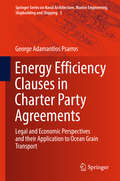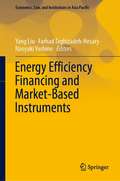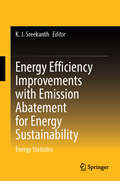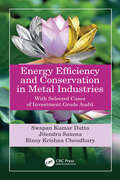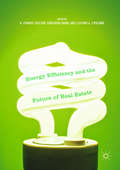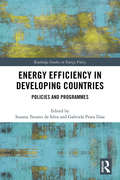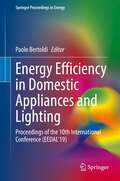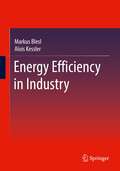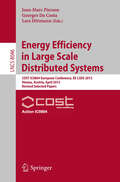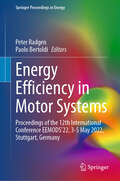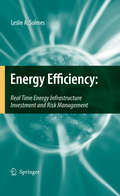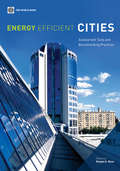- Table View
- List View
Energy Economics and Financial Markets
by André Dorsman Wim Westerman John L. SimpsonEnergy issues feature frequently in the economic and financial press. Specific examples of topical energy issues come from around the globe and often concern economics and finance. The importance of energy production, consumption and trade raises fundamental economic issues that impact the global economy and financial markets. This volume presents research on energy economics and financial markets related to the themes of supply and demand, environmental impact and renewables, energy derivatives trading, and finance and energy. The contributions by experts in their fields take a global perspective, as well as presenting cases from various countries and continents.
Energy Economics and the Environment: Conservation, Preservation and Sustainability
by Mohammad Younus Bhat, Hiranmoy Roy and M. S. BhattEnergy is a basic prerequisite for the growth and development of national wealth. Based on primary research, Energy Economics and the Environment integrates a network of diverse disciplines to provide a theoretical and practical understanding of the constantly neglected challenges associated with conservation, preservation and sustainability of environment and energy. It highlights the issues and prospects in safeguarding environmental biodiversity and renewable energy efficiency, ecosystem chains and human living standards. This book studies the vulnerability associated with global climate alterations that limits direct social and economic benefits from ecosystem goods and services, and presents significant methods through illustrative case studies to tackle energy and environmental questions. In its final analysis, the book proposes possible unconventional mitigation strategies to restore sustainable biodiversity of ecosystems.
Energy Economics: Concepts, Issues, Markets and Governance
by Subhes C. BhattacharyyaThis book provides an updated and expanded overview of basic concepts of energy economics and explains how simple economic tools can be used to analyse contemporary energy issues in the light of recent developments, such as the Paris Agreement, the UN Sustainable Development Goals and new technological developments in the production and use of energy. The new edition is divided into four parts covering concepts, issues, markets, and governance. Although the content has been thoroughly revised and rationalised to reflect the current state of knowledge, it retains the main features of the first edition, namely accessibility, research-informed presentation, and extensive use of charts, tables and worked examples.This easily accessible reference book allows readers to gain the skills required to understand and analyse complex energy issues from an economic perspective. It is a valuable resource for students and researchers in the field of energy economics, as well as interested readers with an interdisciplinary background.
Energy Economics: Markets, History and Policy
by Roy L. NersesianThree quarters of our current electricity usage and transport methods are derived from fossil fuels and yet within two centuries these resources will dry up. Energy Economics covers the role of each fossil and renewable energy source in today’s world, providing the information and tools that will enable students to understand the finite nature of fossil fuels and the alternative solutions that are available. This textbook provides detailed examinations of key energy sources – both fossil fuels and renewables including oil, coal, solar, and wind power – and summarises how the current economics of energy evolved. Subsequent chapters explore issues around policy, technology and the possible future for each type of energy. In addition to this, readers are introduced to controversial topics including fracking and global warming in dedicated chapters on climate change and sustainability. Each chapter concludes with a series of tasks, providing example problems and projects in order to further explore the proposed issues. An accompanying companion website contains extensive additional material on the history of the major types of fuel as well as technical material relating to oil exploration, the development of solar power and historical environmental legislation. This textbook is an essential text for those who study energy economics, resource economics or energy policy.
Energy Economy, Finance and Geostrategy
by Mehmet Baha Karan André B. Dorsman Volkan Ş. EdigerThis volume investigates the impact of energy issues on geostrategy. The crucial importance of energy and the fact that fossil fuels are not equally distributed among countries means that decisions are not only based on financial arguments, but also on the political impact. It can be said that "Energy is Politics". In three parts - 1) Energy Economy; 2) Finance; and 3) Geostrategy - academics and practitioners address both economic and political questions and present cases from several countries.This is the sixth volume in a series on energy organized by the Centre for Energy and Value Issues (CEVI). The previous volumes in the series were: Financial Aspects in Energy (2011), Energy Economics and Financial Markets (2012), Perspectives on Energy Risk (2014), Energy Technology and Valuation Issues (2015) and Energy and Finance (2016).
Energy Effectiveness: Strategic Objectives, Energy and Water at the Heart of Enterprise
by Sandra McCardellThis book describes practical ways to understand energy and water use in organizations and then manage or control that use, thereby reducing risk and cost. The author presents a strategic framework to focus on the types of questions that should be addressed internally, Including evaluation of potential projects, planning and implementing energy projects, and evaluating results. The premise is that no modern organization can exist without energy, despite the fact that energy is also one of the mandatory inputs that receives little to no attention in most organizations. This work highlights methodologies and projects that illuminate ways in which energy management is central to an organization’s success, considering in each case the four main determinants of energy use: People, Buildings, Equipment /Processes, and the Environment. The book constitutes a complete energy savings resource for business owners, middle managers, and building and energy managers, providing options, free tools, and flexible project templates.
Energy Efficiency Applications in Buildings: Volume 1: Theories, Methods, and Tools
by Wei Shi Bertug Ozarisoy Hasim Altan Young Ki KimEnergy Efficiency Applications in Buildings presents an investigation into the energy use and measures to improve the energy efficiency of existing building stock in the UK. The aim of this research is to assess the domestic energy use of statistically representative residential buildings and their occupants’ thermal comfort by considering the significant impact of overheating risks on energy consumption and occupants’ well-being.Divided into two volumes, these books present energy consumption and thermal comfort in the construction sector as a complex socio-technical problem that involves the analysis of an intrinsic interrelationship amongst dwellings, occupants, and the environment. Using case studies, the authors demonstrate the significance of improving energy efficiency and its impact on occupants during long-term heatwaves in the summer. Additionally, the volumes demonstrate how dynamic thermal energy simulation can be used as a learning laboratory for future trends in housing energy consumption reduction.Volume 1: Theories, Methods, and Tools presents the background to the research and the assessment methods and tools adopted by the research team.Volume 2: Performance Evaluation and Retrofitting Strategies describes the case studies and building performance and post-occupancy evaluations, before making strategic policy and retrofitting recommendations.The research and roadmap presented in these volumes can be used as a guidance tool for building energy modelling and performance simulation, enabling architects, building engineers, and other practitioners to close the gap between the current understanding and the actual performance of existing building stocks.
Energy Efficiency Clauses in Charter Party Agreements
by George Adamantios PsarrosThis book provides practical solutions for addressing energy efficiency as a clause term within a charter party contract. For this, upon a reflection of the regulatory craft, it analyzes key concepts of case law, and discusses them together with commercial and economic principles. In this way, the book aims at offering a comprehensive, interdisciplinary view of the chartering process, together with a new approach for safeguarding energy efficiency investments. A special emphasis is given to the maritime industry. Here, the newly developed framework, based on game theory, has been successfully applied to demonstrate the importance of including a clause term in contract negotiation to achieve protection against both an uncertain market and an even more challenging shipping environment. The book not only fills a gap in the literature, covering a topic that has been largely neglected to date, yet it offers researchers and practitioners extensive information to change the chartering process radically.
Energy Efficiency Finance: Assessing the Impact of IFC's China Utility-based Energy Efficiency Finance Program
by World BankThis evaluation assesses the performance of IFC's energy efficiency finance program in China aimed at stimulating energy efficiency investments through bank guarantees and technical assistance. The difference made by the program is traced along the chain of interventions: (i) at the level of banks, the program is narrowly based on one of the two partner banks, which, with the help of the program, expanded its energy efficiency lending as a new business line; (ii) at the level of energy management companies, the program's technical assistance improved the program participants' access to finance; and (iii) at the end-user level, it promoted the use of energy efficiency investments that achieved reduction of greenhouse gas emissions. The utilization of IFC's program has been rapid compared with other similar programs. The energy efficiency investments supported by the program have reduced greenhouse gas emissions by 14 million CO2 tons per year, slightly in excess of the target set at the beginning of the program. However, there is only a weak differentiation in behavior surrounding energy efficiency investment between end users supported by the program and other similar companies that were not. It is important to note that the performance of the program was heavily influenced by the government's policy actions and the earlier efforts of other players: The Chinese government and other players such as the World Bank. The CHUEE program, relying mainly on commercial funding through IFC's guarantees, builds on these efforts
Energy Efficiency Financing and Market-Based Instruments (Economics, Law, and Institutions in Asia Pacific)
by Yang Liu Naoyuki Yoshino Farhad Taghizadeh-HesaryThis book is devoted to investigating the policy design and effectiveness of financial and market-based instruments to promote energy efficiency financing. The concept of this monograph is to present the latest results related to energy efficiency funding schemes, energy efficiency obligations, voluntary agreements, auction mechanisms, and Super Energy Services Companies (Super ESCOs) in major jurisdictions across the world. The book focuses on financial and market-based instruments as they deliver a price signal, which provides an incentive for firms to invest in innovation or implement more energy-efficient technologies and deliver energy savings while minimizing costs. Such instruments can have significant advantages for the government, supporting the fiscal sustainability of the government’s energy efficiency efforts, requiring less enforcement than regulation and according the market flexibility to select the most cost-efficient technologies. This book is highly recommended to researchers, policy experts, and business specialists who seek an in-depth and up-to-date integrated overview of energy efficiency financing.
Energy Efficiency Improvements with Emission Abatement for Energy Sustainability: Energy Statistics
by K. J. SreekanthThe book titled “Energy Efficiency Improvements with Emission Abatement for Energy Sustainability” targets primarily academicians and policy-makers who are involved and practiced in the energy and environment field. It is useful for students, scholars, who wish to obtain an inclusive impression, and those with advanced knowledge can obtain a deeper knowledge of specific issues related with energy statistics, emission reduction and sustainability. Policy-makers in international organizations, national & local governments, companies & trade associations, and NGOs can use it as a source of inspiration for future policymaking as well as for a better understanding about the consumer behavior while dealing with energy. The book obviously targets those interested in energy and associated aspects, its setbacks, though there may be close parallels with social and behavioral issues. While its scope is international, this book may also be relevant to readers concerned with domestic areas of precise country and continental interest, as these are increasingly uncovered to developmental issues in energy. The book addresses the following major aspects: • The energy statistics assessment for energy sustainability with an emission abatement approach. • The relationship between energy statistics and major greenhouse gas emissions, explained in the energy efficiency context. • The relevant policy directions in the energy statistics direction. • The impact of climate change, and its effect on various sectors/countries and the role of energy statistics on them. Those who are interested in the interpretation of statistical data on energy resources and pollution, latest innovations in energy markets, energy technology and services, carbon mitigation, can make this book useful.
Energy Efficiency Policies
by Victor AndersonAny attempts to control the greenhouse effect will involve reducing carbon dioxide emissions and therefore requires energy efficiency. Victor Anderson analyses ways in which energy can be used more economically and discusses effective policies for promoting this. Specific case studies are used to illustrate previous attempts to introduce policies aimed at reducing consumption of energy and offers a practical and topical guide to tackling the effects of global warming in the future.
Energy Efficiency and Conservation in Metal Industries: With Selected Cases of Investment Grade Audit
by Swapan Kumar Dutta Jitendra Saxena Binoy Krishna ChoudhuryThis book provides a deep insight into the energy usage in the energy intensive metal industry and the methodology for efficiency assessment. Various methodologies for energy audits are described, along with concept-level analysis for minimum energy design. Apart from the technical and engineering analysis, the book also describes management aspects such as energy management systems and financial, environmental and social analysis leading to the development of a comprehensive plan for implementation of energy efficiency and conservation in industries. Barriers to investment in energy efficiency and conservation are discussed, based on review of global and Indian case studies. FEATURES: Details fundamental principles driving energy consumption in an industrial set-up backed with illustrative examples Explains various alternative methods for discovery of energy efficiency and conservation projects. Focusses on metal-producing and -processing facilities with an emphasis on environmental quality Supports maximum digitalization of energy audit assessment and report preparation processes Includes global case studies and tutorials at the end of the corresponding chapters This book is useful for researchers, professionals and graduate students in thermodynamics, manufacturing, thermal engineering, energy engineering, energy efficiency and energy processes, especially in the metal industry.
Energy Efficiency and Renewable Energy Policies (Synthesis Lectures on Renewable Energy Technologies)
by Neyre Tekbıyık ErsoyAlthough there are many publications about energy efficiency policies and renewable energy policies, most of them are specific to some countries or regions. As most of these publications focus on country and region specific issues, they may not be preferred in teaching the energy related policies in a university not from that country or region. The author has been teaching a course called “Energy Laws and Policies” for a long time. Over the years, she prepared detailed lecture notes about energy efficiency policies and renewable energy policies which are the basis of this book. It can be used by instructors around the World, or by students/individuals who want to learn more about these policies. It is aimed to serve as a textbook for undergraduate, and graduate level students. The book includes the definitions, types, advantages/disadvantages of energy efficiency policies and renewable energy policies in general. It also provides a comparative analysis on energy efficiency and renewable energy policy preferences of different countries. It will help the students to better understand the major differences between policies, how they are applied and which policies should be preferred under which conditions.
Energy Efficiency and the Future of Real Estate
by Yongsheng Wang N. Edward Coulson Clifford A. LipscombThis book explores how energy efficiency is a major component in the development of sustainable real estate. Efficiency is one of the most frequently-mentioned aspects of government policies for green building design in the United States and around the world. There has been a significant amount of effort devoted to the creation of green practices in real estate, including building construction, building assessment, city planning, investment, governmental regulation and policies, and industrial development. One of the key emphases of the above activities is energy efficiency, thus it is crucial for researchers and readers to have a comprehensive overview of the topic, as this book provides.
Energy Efficiency in Developing Countries: Policies and Programmes (Routledge Studies in Energy Policy)
by Suzana Tavares Da Silva Gabriela Prata DiasThis book presents a comparative analysis of energy efficiency policies in developing countries. Although there is a vast amount of literature available about renewable energy policy and implementation in the developing world, energy efficiency tends to lack attention. This book fills this lacuna by examining the current state of the field and scope for future improvements. Drawing on a wide range of case studies including Brazil, China and Chile, the authors use a comparative approach to examine the policies and programmes being implemented, looking at the existing legal frameworks and regulatory challenges. By showcasing stories of success, as well as barriers to energy efficiency, they highlight the opportunities for increased energy access and efficiency and demonstrate how these opportunities may directly impact on climate change mitigation. This volume will be a useful resource for scholars and practitioners with an interest in energy policy and efficiency, climate change and international development.
Energy Efficiency in Domestic Appliances and Lighting: Proceedings of the 10th International Conference (EEDAL'19) (Springer Proceedings in Energy)
by Paolo BertoldiThis book contains peer-reviewed papers presented at the 10th International Conference on Energy Efficiency in Domestic Appliances and Lighting (EEDAL'19), held in Jinan, China from 6-8 November 2019.Energy efficiency helps to mitigate CO2 emissions and at the same time increases the security of energy supply. Energy efficiency is recognized as the cleanest, quickest and cheapest energy source. Not only this, but energy efficiency brings several additional benefits for society and end-users, such as lower energy costs, reduced local pollution, better outdoor and indoor air quality, etc.However, in some sectors, such as the residential sector, barriers to investments in energy efficiency remain. Legislation adopted in several jurisdictions (EU, Japan, USA, China, India, Australia, Brazil, etc.) helps in removing barriers and fosters investments in energy efficiency. These initiatives complement innovative financing schemes for energy efficiency, the provision of energy services by energy service companies and different types of information programs. At the same time, progress in appliance technologies and in solid state lighting offer high levels of efficiency. LED lighting is an example. As with previous conferences in this series, EEDAL’19 provided a unique forum to discuss and debate the latest developments in energy and environmental impact of households, including appliances, lighting, heating and cooling equipment, electronics, smart meters, consumer behavior, and policies and programs. EEDAL addressed non-technical issues such as consumer behavior, energy access in developing countries, and demand response.
Energy Efficiency in Industry
by Markus Blesl Alois KesslerThis book quantifies the potential for greater energy efficiency in industry on the basis of technology- and sector-related analyses. Starting from the methodological fundamentals, the first part discusses the electricity- and heat-based basic technologies and cross-sectional processes on the basis of numerous application examples. In addition to classic topics such as lighting and heat recovery, the study also covers processes that have received less attention to date, such as drying and painting. The second part is devoted to energy-intensive industries, in particular metal production and processing, the manufacture of the non-metallic materials cement and glass, and the chemical, paper, plastics and food industries. Both parts are concluded by placing them in a larger energy and economic context. The findings are condensed into checklists at many points and summarized in the overall view at the end to form generally applicable recommendations.This book is a translation of the original German 2nd edition Energieeffizienz in der Industrie by Markus Blesl and Alois Kessler, published by Springer-Verlag GmbH Germany, part of Springer Nature in 2017. The translation was done with the help of artificial intelligence (machine translation by the service DeepL.com). A subsequent human revision was done primarily in terms of content, so that the book will read stylistically differently from a conventional translation. Springer Nature works continuously to further the development of tools for the production of books and on the related technologies to support the authors.
Energy Efficiency in Large Scale Distributed Systems
by Lars Dittmann Jean-Marc Pierson Georges Da CostaThis book constitutes revised selected papers from the Conference on Energy Efficiency in Large Scale Distributed Systems, EE-LSDS, held in Vienna, Austria, in April 2013. It served as the final event of the COST Action IC0804 which started in May 2009. The 15 full papers presented in this volume were carefully reviewed and selected from 31 contributions. In addition, 7 short papers and 3 demo papers are included in this book. The papers are organized in sections named: modeling and monitoring of power consumption; distributed, mobile and cloud computing; HPC computing; wired and wireless networking; and standardization issues.
Energy Efficiency in Motor Systems: Proceedings of the 12th International Conference EEMODS’22, 3-5 May 2022, Stuttgart, Germany (Springer Proceedings in Energy)
by Peter Radgen Paolo BertoldiThis book contains selected, peer-reviewed papers presented at the 12th International Conference on Energy Efficiency in Motor Systems (EEMODS'22), held in Stuttgart, Germany from May 3-5, 2022. As with previous conferences in this series, EEMODS’22 provided a scientific forum to discuss and debate the latest developments and impacts of electrical motor systems on energy and the environment, energy efficiency policies and programs adopted and planned, standards (including ISO 50.001), and the technical and commercial advances made in the dissemination and penetration of energy-efficient motor systems. Topics covered include emerging motor technologies, research and innovation in electric motors, power electronics and drives, pump systems, market surveillance and enforcement mechanisms, national energy efficiency standards including case studies, plus much more. The conference is international by nature and aims to attract high quality and innovative contributions from all corners of the globe, while the papers facilitate the development of new technologies, policies and strategies to increase energy efficiency.
Energy Efficiency in the Urban Environment
by Heba Allah Khalil Essam E. KhalilEnergy Efficiency in the Urban Environment is a study of energy crisis, urbanisation, and climate change, as well as a discussion of how to combat these global challenges. With a special focus on Egypt, this book addresses the macroscale of urbanism from the perspective of city dwellers' quality of life, and explores the microscale of buildings and
Energy Efficiency: Building a Clean, Secure Economy
by James L. SweeneyThe entire world, especially the United States, is in the midst of an energy revolution. Since the oil embargo of 1973, individuals, corporations, and other organizations have found ways to economically reduce energy use. In this book, Jim Sweeney examines the energy policies and practices of the past forty years and their impact on three crucial systems: the economy, the environment, and national security. He shows how energy-efficiency contributions to the country's overall energy situation have been more powerful than all the increases in the domestic production of oil, gas, coal, geothermal energy, nuclear power, solar power, wind power, and biofuels. The author details the impact of new and improved energy-efficient technologies, the environmental and national security benefits of energy efficiency, ways to amplify energy efficiency, and more. Energy Efficiency: Building a Clean, Secure Economy reveals how the careful nurturing of private- and public-sector energy efficiency--along with public awareness, appropriate pricing, appropriate policies--and increased research and development, the trends of decreasing energy intensity and increasing energy efficiency can be beneficially accelerated.
Energy Efficiency: Real Time Energy Infrastructure Investment and Risk Management
by Leslie A. SolmesENERGY EFFICIENCY uses an applied scientific methodology and case studies to demonstrate and support: The need for the U.S. and the world to commit to energy and resource efficiency as the central goal in investing in electric, heat, and cooling infrastructure, the huge economic opportunity for using the inefficiency built into 20th century energy supply systems, especially, electric, to pay for the upgrades, replacements, and new production and distribution systems of the 21st century, the importance of adopting a standard, web-based energy infrastructure investment decision-making and risk management tool that will serve as a communication medium for all stakeholders to evaluate and compare energy infrastructure investment options and manage investment risks, expansions of the U.S. 'smart' grid investment to include evaluation and risk management of energy systems infrastructure investments not just electricity operations, the need to adopt a 'framework' for utilities, energy service companies, and customers to work together to close business deals, communicate and manage risks, and realize profits.
Energy Efficient Affordable Housing: Policy Design and Implementation in Canadian Cities
by Sasha TsenkovaThis book provides the first comparative assessment of the energy-efficiency retrofit programs in the social housing sector of Canadian cities, focusing on program efficiency and effectiveness. The analytical framework explores key policy instruments - regulatory, fiscal and institutional - in relation to major results achieved. The approach is interdisciplinary, supported by rich empirical data from case studies, observations and interviews. The book explores important strategies for the provision of green and affordable housing, while addressing climate change imperatives and resilience issues. This is of great interest to researchers, policy makers, city leaders, professionals and students. Its value added contribution to scholarship is complemented by practical relevance for social housing organisations in countries with a small residual housing sector. It offers valuable lessons for the design, planning and implementation of energy retrofit programs in North America and beyond.
Energy Efficient Cities: Assessment Tools and Benchmarking Practices
by Ranjan K. BoseUrban areas account for two-thirds of global energy requirements while housing approximately half of the world's population. With current projections indicating that 70 percent of the world's population will live in cities by 2050, an increase in urban energy use is inevitable. In the face of this growing energy demand, developing climate-friendly urban energy solutions, while protecting the urban development that is crucial to socioeconomic progress in developing countries, is imperative. In an effort to catalyze solutions that would delink high levels of carbon-intensive energy use from urban growth, the Energy Sector Management Assistance Program (ESMAP) of the World Bank launched the Energy Efficient Cities Initiative in October 2008. 'Energy Efficient Cities: Assessment Tools and Benchmarking Practices' is a product of that initiative. The analytical tools and policy insights offered in this volume extend from integrated assessments of new cities to the impacts of socioeconomic, climate, and demographic changes on existing cities. In addition, the documentation and benchmarking of a variety of low-carbon and carbon-neutral good practices provide a range of practical insights on plausible energy efficient interventions in urban sectors. This book will be of particular interest to policy makers, development practitioners, and decision makers in the private sector, as well as researchers within nongovernmental organizations and the academic community.
